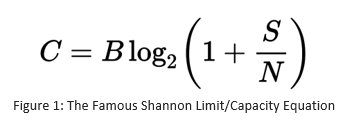Shannon’s Limit, or Opportunity?
For several years now, the submarine network industry has benefitted from the arrival of coherent-based modems allowing cable operators to upgrade their submerged network assets to previously unthinkable total information-carrying capacities. Channel speeds initially increased from 10Gb/s to 40Gb/s, then to 100Gb/s, and now even higher. Submarine cables deployed many years ago are now supporting an order of magnitude increase in total information-carrying capacity. The exact total capacity of an upgraded cable depends upon its unique performance personality, but all increases are indeed astounding. Such cable upgrades breathed new life into existing subsea wet plants, some over a decade old, and allows cable operators to maintain pace with over 40% CAGR in demand.
The introduction of coherent Submarine Line Terminating Equipment (SLTE) was a sea change milestone in the industry, with operators getting used to massive increases in capacity their subsea assets could support. However, there’s a looming limit to how many bits can be crammed into an optical fiber, known as the Shannon Limit. It’s a red-hot topic of discussion these days, and rightfully so.
There’s a looming limit to how many bits can be crammed into an optical fiber, known as the Shannon Limit. It’s a red-hot topic of discussion these days, and rightfully so.
What Is Shannon’s Limit?
 A brilliant renaissance man named Claude Shannon, rightfully referred to as the Father of Information Theory, wrote a groundbreaking paper back in 1948 that essentially created the discipline of information theory as we know it today – 70 years ago! His paper showed that any communications channel, a fiber optic-based submarine cable in our case, is characterized by bandwidth and noise. Bandwidth is the range of optical frequencies (usable wet plant spectrum) that can transmit a signal. Noise is anything that disturbs this signal, such as the linear and nonlinear effects associated with submarine fiber optic-based communications.
A brilliant renaissance man named Claude Shannon, rightfully referred to as the Father of Information Theory, wrote a groundbreaking paper back in 1948 that essentially created the discipline of information theory as we know it today – 70 years ago! His paper showed that any communications channel, a fiber optic-based submarine cable in our case, is characterized by bandwidth and noise. Bandwidth is the range of optical frequencies (usable wet plant spectrum) that can transmit a signal. Noise is anything that disturbs this signal, such as the linear and nonlinear effects associated with submarine fiber optic-based communications.
Seems simple enough, right?
Shannon showed how to calculate the maximum data rate over a communications medium (ex. submarine cable), in the presence of noise, without incurring transmission errors and referred to it as the Channel Capacity. In the submarine industry, it’s often referred to as the Shannon Limit, and is essentially the same thing.
So why does all this matter? It’s because we’re approaching the Shannon Limit when it comes to the maximum information-carrying capacities of both existing and new submarine cables. This means the days of massive increases in per channel capacities may be coming to an end – but there’s hope, or opportunity, on the horizon so all is not lost!
Simple equation, profound consequences
The mathematical equation defining Shannon’s Capacity Limit is shown below, and although mathematically simple, it has very complex implications in the real world where theory and engineering rubber meets the road. This simple equation has profound consequences, if not taken into account when planning and designing new submarine cables… have you taken Shannon’s Limit into account?

Now that we’ve seen the Shannon Limit equation, let’s dive deeper to understand its profound effect on our industry. The maximum capacity that can be carried over the communication medium, a submarine cable optical fiber, is “C”, given in bits per second (b/s). The available bandwidth, given in Hertz, is “B” and represents the total amount of usable submarine cable optical spectrum. The Signal-to-Noise ratio of power levels is represented by S/N, and being a ratio, it has no units.
The implication of this equation is quite clear; if you want to increase the total information-carrying capacity (C) of your submarine cable optical fiber, you increase the amount of usable spectrum (B), increase the signal level, and/or reduce the noise level. There are also real-world limitations (ex. nonlinear impairments, FEC overhead, performance margins, component aging) to account for, which will decrease the achievable capacity.
Approaching the Shannon Limit
To get closer to the Shannon Limit, there’s a wealth of technological wizardry being incorporated into the newest coherent-based SLTE, such as our latest generation WaveLogic Ai-based submarine modems. It’s the ingenious advancements and integration of software, hardware, and mathematics that have allowed us to create revolutionary modems that will once again change our industry. For a single optical fiber, we’ll eventually reach the limit into how much coherent-based capacity we can cram into it – after all, it’s a limit!
Fortunately, there are techniques besides modem-centric advances that address the Shannon Limit. For instance, we can increase the bandwidth (B) in Shannon’s equation by exploiting the L-band that essentially doubles the available spectrum, deploy wider band repeaters with more usable spectrum, deploy more fiber pairs per submarine cable to multiply the overall available spectrum, and integrate newer multi-core fibers into future wet plants. We can also increase C by increasing the SNR by leveraging Raman amplification, the latest in lower loss fibers, and higher TOP (Total Output Power) within subsea optical fibers.
There are cost and performance tradeoffs associated with all of these options, but they represent opportunities to challenge Shannon’s Limit, directly and indirectly. It should be noted that many of these techniques are only applicable to new submarine wet plants, before they’re deployed on the bottom of the seabed, so know that wet plant technology decisions taken will ultimately dictate your Shannon Limit, meaning a low initial cost wet plant will likely hamper its future information-carrying capacity. This is why each and every submarine cable has, and will continue to have, a very unique personality in terms of performance.
Wet plant technology decisions taken will ultimately dictate your Shannon Limit, meaning a low initial cost wet plant will likely hamper its future information-carrying capacity.
Optimizing submarine cable capacity
There are also opportunities outside of the optical transmission domain that can be leveraged, such as statistically multiplexed packet switching, which allows cable operators to migrate from traditional Time Division Multiplexing (TDM), which consumes bandwidth whether it’s being used or not, to statistically multiplexing that comparatively optimizes available bandwidth utilization. Packet switching allows far more user traffic to be carried over the same physical submarine network because it exploits the statistical nature of data traffic, which represents the vast majority of submarine cable traffic both today and well into the future. The beauty of the packet-based switching option is that it’s equally applicable to both existing and new submarine cables – bonus!
It should also be noted that the amount of existing lit bandwidth already in use isn’t always being used in the most optimized manner. For instance, protection bandwidth is often dedicated in case of a network fault, but under normal conditions this protection bandwidth could be generating revenue. Traffic also often doesn’t follow the most optimized path to its destination, which leads to the inefficient consumption bandwidth along its path between endpoints. By virtualizing underlying physical network assets, overland and undersea, SDN control-based intelligence can better optimize the consumption of available bandwidth on an ongoing basis. This implicitly delays having to deal with Shannon’s Limit, since the better use of overall bandwidth effectively means that less bandwidth is required.
Typical submarine cables are design for guaranteed full-fill End-of-Life (EOL) performance, meaning early on in its submarine cable 25-year lifespan, more traffic can be transported by “borrowing” some EOL margin to increase channel rates via intelligent SLTE, such as those based on our latest WaveLogic Ai-based modems. As bandwidth-on-demand consumption models continue to be adopted across all parts of the global network, borrowing EOL margins for temporary increases in overall submarine cable information-carrying capacity just makes sense. At Ciena, we call this Liquid Spectrum, and will truly be an optical game changer, overland and undersea.
If you’d like to hear more about Shannon’s Limit, check out our CTO’s keynote presentation at Submarine Networks World below. I also encourage you to attend the two panel discussions below that look to be interesting discussion among several industry experts.
We’re also available to meet face-to-face as well, so drop by our booth to discuss submarine network topics live. See you there!
Monday, September 25, 2017
09:35: “Shannon Limit… or Opportunity?” keynote presentation by Steve Alexander, Senior VP & Chief Technology Officer
16:55: “Evaluating the Business of an Open Network” panel with Bob Hadaway, VP of Product Line Management
Tuesday, September 26
09:20: “New Network Topologies for a Next Generation Internet” panel with Ian Clarke, VP of Global Submarine Solutions






